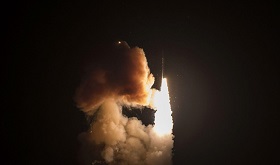The resumption of U.S.–Russia consultations on arms control and strategic stability in Vienna in late June is certainly good news. If the discussions go well, then there may be hope that the Treaty between the United States of America and the Russian Federation on Measures for the Further Reduction and Limitation of Strategic Offensive Arms (New START) will be extended after all. If the sides fail to come to an agreement, the likelihood of which, unfortunately, is extremely high, then in February 2021, New START will suffer the same fate as the Soviet–American Intermediate-Range Nuclear Forces and Anti-Ballistic Missile treaties, and the multilateral Treaty on Conventional Armed Forces in Europe (CFE).
I remember well how hard we fought to preserve the Anti-Ballistic Missile Treaty (ABM Treaty) at the turn of the century. The Russian side was prepared to make some serious compromises to convince Washington to keep the Treaty alive. The overwhelming majority of countries around the world spoke out in favour of maintaining and observing the ABM Treaty. The UN General Assembly even drew up a resolution to preserve it, with only four countries voting against it. Alas, the Treaty could not be saved, as the United States unilaterally withdrew from it in the summer of 2002.
Perhaps the term “arms control” may itself need revising in the future. Legally binding, predominantly quantitative “arms control” may very well be replaced by multilateral, informal and predominantly qualitative “strategic arms management.” This new system will be predicated on the existence of numerous communication channels at various levels (i.e. not just the highest level), as well as on the timely exchange of military information, the comparison of military doctrines, perceived threats and plans for the development of strategic forces, joint action against the proliferation of nuclear weapons, countering nuclear terrorism and so on.
We are witnessing the dawn of a new era in our nuclear world, a world that is becoming more complex, less predictable and potentially more dangerous than the world of the 20th century. I would like to hope that Russia, the United States and other leading countries can get past their mutual suspicions and reproaches, understand the magnitude of the growing risks and direct their efforts towards the search for new models and new algorithms for reducing the nuclear threat and strengthening strategic stability at the global and regional levels. Russia could take the lead in this process, as our country has unique experience in developing and using the most diverse arms control mechanisms, a rich tradition of training Soviet and Russian negotiators, and a community of highly qualified strategic arms experts.
The resumption of U.S.–Russia consultations on arms control and strategic stability in Vienna in late June is certainly good news. If the discussions go well, then there may be hope that the Treaty between the United States of America and the Russian Federation on Measures for the Further Reduction and Limitation of Strategic Offensive Arms (New START) will be extended after all. If the sides fail to come to an agreement, the likelihood of which, unfortunately, is extremely high, then in February 2021, New START will suffer the same fate as the Soviet–American Intermediate-Range Nuclear Forces and Anti-Ballistic Missile treaties, and the multilateral Treaty on Conventional Armed Forces in Europe (CFE).
I remember well how hard we fought to preserve the Anti-Ballistic Missile Treaty (ABM Treaty) at the turn of the century. The Russian side was prepared to make some serious compromises to convince Washington to keep the Treaty alive. The overwhelming majority of countries around the world spoke out in favour of maintaining and observing the ABM Treaty. The UN General Assembly even drew up a resolution to preserve it, with only four countries voting against it. Alas, the Treaty could not be saved, as the United States unilaterally withdrew from it in the summer of 2002.
The same would soon happen with the Treaty on Conventional Armed Forces in Europe (CFE) and the Intermediate-Range Nuclear Forces Treaty (INF Treaty). Admittedly, we did not fight as hard to preserve these agreements. We did make calls at the highest political level for them to be saved, but things never went beyond Russia stating its principled position on the matter. And Europe, whose security interests were directly linked to these treaties and which had at one time backed them to their fullest, effectively sided with Washington on the matter and looked on feebly as they were torn down.
Is New START prepared to suffer the same fate? It is probably too early to start making predictions. However, it is already clear that even if the Treaty is extended, it will be almost impossible to restore the ramified and multilevel legal framework for arms control that had been created during the second half of the 20th century and which provided strategic stability in the world. If we agree with this picture of our current reality, then two practical questions arise. First: Is it time to admit that traditional control over nuclear and conventional arms cannot be restored by the start of the 2020s? Second: What arms control mechanisms are possible in emerging international conditions?
Obviously, the United States bears the brunt of the blame for the collapse of the international arms control system. After the Cold War, Washington, believing that it had “won,” brazenly started to fly in the face of those international mechanisms which, in the opinion of several U.S. administrations, might somehow give them less room for manoeuvre on the international stage and stand in the way of U.S. dominance.
The United States unilaterally withdrew from the ABM and INF treaties, did everything in its power to prevent its partners in NATO from ratifying an adapted version of the CFE Treaty, and avoided a constructive dialogue on other areas of arms control. In this sense, the signing of the New START agreement in 2010 was rather an exception to the general trend.
That said, it would be a dangerous oversimplification to suggest that the United States is the only party responsible for the current state of affairs in arms control. We cannot ignore the fact that the world ceased being bipolar when the Cold War ended, and this extended to the nuclear threat as well. In terms of security, we no longer focus exclusively on a global threat, but also, and perhaps more so, on regional and domestic threats. At the same time, the scale of priorities in regard to these threats started to change, with the fight against terrorism, extremism, drug trafficking, illegal migration, etc., taking priority.
In this climate, the international community was extremely critical of India and Pakistan when it emerged that they had developed their own nuclear weapons. Still, no one thought to take any steps to prevent them from doing so. The only way to explain this is that the development of nuclear weapons in these countries, while a direct violation of the non-proliferation regime, is perceived as a regional problem, rather than a threat to global security. We need to acknowledge that the five permanent members of the UN Security Council (the “nuclear five”) are, to some extent, responsible for the current state of affairs.
From today’s vantage point, the 50-year history of nuclear arms control looks increasingly disappointing. The arms control that we have known since Brezhnev and Nixon signed the first agreements half a century ago is nearing its natural conclusion. The recent destructive steps of the Trump administration have likely brought the end even closer, adding an extra pinch of drama to the proceedings. But the end was somehow inevitable. In any case, we cannot go back to the 1970s, or even to 2010, when Dmitry Medvedev and Barack Obama signed New START.
On the other hand, it is difficult to imagine that there are states in the world that are interested in a nuclear arms race without restrictions. A “game without rules” in this area is too risky, and these risks will only increase with each passing decade, if not each passing year. Consequently, any new strategic arms control mechanism will have to somehow sprout through the debris of the old bilateral U.S.–Soviet system.
Today, no one can predict exactly what these new mechanisms will be. What we likely can say with greater certainty is what they will not be. The bilateral format of strategic arms control will remain a thing of the past. The United States is increasingly concerned about China developing its own nuclear arsenal, the ballistic potential of Iran, etc. Russia, in turn, will have to take the ever-increasing capabilities of the official and unofficial members of the “nuclear club,” as well as those of the United States, into account. Accordingly, the bilateral U.S.–Russia format will somehow have to be transformed into a multilateral configuration. This is no trivial task, but one that needs to be tackled, nevertheless.
Future agreements are unlikely to take the form of traditional, legally binding and ratified treaties. It is extremely difficult, and often impossible, to ratify international agreements these days, especially because we have to go through a historically long period of tense confrontation between the world's leading actors first. What guarantees can the parties give in these conditions that they will honour the agreements reached? As the experience of the INF and ABM treaties has shown us, even legally binding agreements do not provide such guarantees, as a few simple formal procedures are enough to pull out of any agreement.
We can also assume that any future arrangements on strategic arms control will not focus on specific numbers of nuclear missiles, bombers, warheads and launchers. I very much doubt that we will see another quantitative arms race similar to the one that the Soviet Union and the United States engaged in during the second half of the 20th century. The main headache in the negotiations will be caused by the qualitative, rather than the quantitative, aspects of the countries’ strategic arsenals. One example here is the growing use of artificial intelligence in the nuclear sphere.
As for the negotiation formats and possible agreements, we can expect traditional bilateral models to be replaced by more flexible multilateral formats such as the 2015 Joint Comprehensive Plan of Action (JCPOA) on the Iranian nuclear programme. Of course, as we have seen, even this format does not guarantee that agreements will be honoured. What it does do, however, is provide an opportunity to develop solutions on which a large number of states can agree, which, in turn, reduces tensions.
Perhaps the term “arms control” may itself need revising in the future. Legally binding, predominantly quantitative “arms control” may very well be replaced by multilateral, informal and predominantly qualitative “strategic arms management.” This new system will be predicated on the existence of numerous communication channels at various levels (i.e. not just the highest level), as well as on the timely exchange of military information, the comparison of military doctrines, perceived threats and plans for the development of strategic forces, joint action against the proliferation of nuclear weapons, countering nuclear terrorism and so on.
We are witnessing the dawn of a new era in our nuclear world, a world that is becoming more complex, less predictable and potentially more dangerous than the world of the 20th century. I would like to hope that Russia, the United States and other leading countries can get past their mutual suspicions and reproaches, understand the magnitude of the growing risks and direct their efforts towards the search for new models and new algorithms for reducing the nuclear threat and strengthening strategic stability at the global and regional levels. Russia could take the lead in this process, as our country has unique experience in developing and using the most diverse arms control mechanisms, a rich tradition of training Soviet and Russian negotiators, and a community of highly qualified strategic arms experts.







